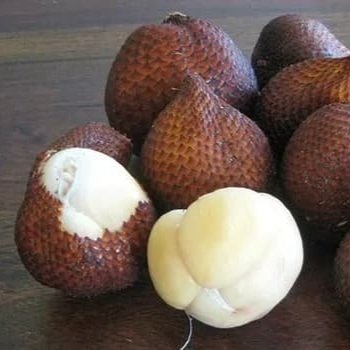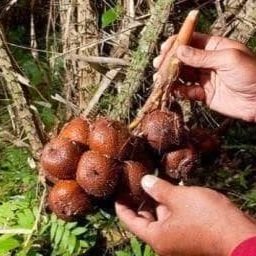Salacca Zalacca var. "Bali Salak Gula Pasir"
Salak Gula Pasir, the sweetest Salak Bali cultivar, lives up to its name, meaning "Sanding Sugar" in English, with a flavor almost as sweet as sugar when fully ripe. The fruit is round with blackish-brown, soft-spined skin and white pulp that lacks the thin membrane found in Salak Pondoh. A variety of Salacca zalacca var. amboinensis, this apomictic palm grows up to 4 meters tall and features narrower, evenly spaced leaflets. Its basal inflorescence produces clusters of 10 to 20 fruits, which are laterally flattened, divided into three segments, and typically contain 0–1 loose seed. The fruits, harvested from late summer to autumn, are exceptionally sweet with almost no acidity, making them perfect for eating raw or in jams. Unlike the typical S. zalacca, Bali cultivars are astringent before ripening but sweeter overall. You are purchasing a single seed. Seeds are shipped in humid vermiculite.
Salak Gula Pasir, the sweetest Salak Bali cultivar, lives up to its name, meaning "Sanding Sugar" in English, with a flavor almost as sweet as sugar when fully ripe. The fruit is round with blackish-brown, soft-spined skin and white pulp that lacks the thin membrane found in Salak Pondoh. A variety of Salacca zalacca var. amboinensis, this apomictic palm grows up to 4 meters tall and features narrower, evenly spaced leaflets. Its basal inflorescence produces clusters of 10 to 20 fruits, which are laterally flattened, divided into three segments, and typically contain 0–1 loose seed. The fruits, harvested from late summer to autumn, are exceptionally sweet with almost no acidity, making them perfect for eating raw or in jams. Unlike the typical S. zalacca, Bali cultivars are astringent before ripening but sweeter overall. You are purchasing a single seed. Seeds are shipped in humid vermiculite.
Salak Gula Pasir, the sweetest Salak Bali cultivar, lives up to its name, meaning "Sanding Sugar" in English, with a flavor almost as sweet as sugar when fully ripe. The fruit is round with blackish-brown, soft-spined skin and white pulp that lacks the thin membrane found in Salak Pondoh. A variety of Salacca zalacca var. amboinensis, this apomictic palm grows up to 4 meters tall and features narrower, evenly spaced leaflets. Its basal inflorescence produces clusters of 10 to 20 fruits, which are laterally flattened, divided into three segments, and typically contain 0–1 loose seed. The fruits, harvested from late summer to autumn, are exceptionally sweet with almost no acidity, making them perfect for eating raw or in jams. Unlike the typical S. zalacca, Bali cultivars are astringent before ripening but sweeter overall. You are purchasing a single seed. Seeds are shipped in humid vermiculite.




